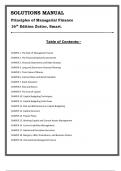SOLUTIONS MANUAL
Principles of Managerial Finance
16th Edition Zutter, Smart.
Table of Contents:-
CHAPER 1. The Role of Managerial Finance
CHAPER 2. The Financial Market Environment
CHAPER 3. Financial Statements and Ratio Analysis
CHAPER 4. Long and Short-term Financial Planning
CHAPER 5. Time Value of Money
CHAPER 6. Interest Rates and Bond Valuation
CHAPER 7. Stock Valuation
CHAPER 8. Risk and Return
CHAPER 9. The Cost of Capital
CHAPER 10. Capital Budgeting Techniques
CHAPER 11. Capital Budgeting Cash Flows
CHAPER 12. Risk and Refinements in Capital Budgeting
CHAPER 13. Capital Structure
CHAPER 14. Payout Policy
CHAPER 15. Working Capital and Current Assets Management
CHAPER 16. Current Liabilities Management
CHAPER 17. Hybrid and Derivative Securities
CHAPER 18. Mergers, LBOs, Divestitures, and Business Failure
CHAPER 19. International Managerial Finance
,Chapter No 1: The Role of Managerial Finance
Overview
This chapter introduces the field of finance through building-block terms and concepts. The chapter
starts byexplaining what a firm is and discussing the goals that managers of a firm might pursue. The
chapter providesa justification for focusing on shareholders rather than stakeholders broadly, but it also
discusses other goalsthat firms might pursue. The opening section concludes with material on the
importance of ethical behavior inbusiness.
The next section discusses the managerial finance function, the key decisions that financial managers
make, and the principles that guide their decisions. The discussion draws out distinctions among the
overlapping disciplines of finance, economics, and accounting.
The third section describes pros and cons of different legal forms for a business. This section places
particular emphasis on differences in taxation of proprietorships, partnerships, and corporations, and it
highlights the importance of the marginal tax rate rather than the average tax rate. Next, this section
describes the classical principal-agent problem and describes both internal and external corporate
governance mechanisms that help manage that problem.
This chapter and the ones to follow stress the important role finance vocabulary, concepts, and tools will
play in the professional and personal lives of students—even those choosing other majors, such as
accounting, economics information systems, management, marketing, or operations. Whenever
possible, personal-finance applications are provided to motivate and illustrate topics. This pedagogical
approach should inspire students to master chapter content quickly and easily.
Suggested Answer to Opener-in-Review
Students learned the stock price of Brookdale Senior Living lost 80% of its value from 2015 to 2019,
prompting Land and Buildings (a prominent stockholder) to urge the firm sell its real-estate holdings,
distribute the anticipated net sales proceeds ($21 cash) to shareholders, and then focus on managing its
senior living facilities. Students were asked whether the proposal would make Brookdale’s shareholders
better off if the expected cash proceeds were realized, but stock price dipped to $5 per share.
Before restructuring, an investor with one Brookdale share had $21.35 in total wealth. Afterward, that
same investor might have a share worth $5 and $21 in cash—total wealth of $26. The hypothetical
shareholder reaped a gain of $4.65 per share or 21.8%. Before the asset sale, with 185.45 million shares
outstanding and a share price of $21.35, total shareholder wealth was $3.96 billion. After the sale, with
same shares outstanding and wealth per share now $26, shareholder wealth rose to $4.82 billion—a net
gain of $0.86 billion.
Here is a discussion question for the class to motivate future exploration of CEO compensation: Suppose
Brookdale’s CEO came up with the asset-sale idea rather than a prominent shareholder, and Brookdale’s
board rewarded him with a $1 million dollar bonus—a figure alone that would easily vault the CEO into
the top 1% of U.S. income earners. Is the CEO’s compensation excessive?
,Answers to the Review Questions
1-1 The goal of a firm, and therefore of all financial managers, is maximizing shareholder wealth. The
proper metric for this goal is the price of the firm’s stock. Other things equal, an increasing price per
share of common stock relative to the stock market as a whole indicates achievement of this goal.
1-2 Actions that maximize the firm’s current profit may not produce the highest stock price because (1)
some firm activities that result in slightly lower profit today generate much larger profits in the future
periods (i.e., focusing on current profit overlooks the time value of money); (2) activities that generate
higher accounting profits today may not result in higher cash flows to stockholders; and (3) activities
that lead to high profits today may involve higher risk, which could result in significant future losses.
1-3 Risk is the chance actual outcomes may differ from expected outcomes. Financial managers must
consider risk and return because the two factors tend to have an opposite effect on share price. That is,
other things equal, an increase in the risk of cash flows to shareholders will depress firm stock price
while higher average cash flows to shareholders will increase stock price.
1-4 Maximizing shareholder wealth does not mean overlooking or minimizing the welfare of other firm
stakeholders. Firms with satisfied employees, customers, and suppliers tend to produce higher (or less
risky) cash flows for their shareholders compared with companies that neglect non-owner stakeholders.
That said, customers prefer lower prices for firm output, firm employees prefer higher wages, and firm
suppliers prefer higher prices for the input goods and services they provide. So actions that produce the
highest price of the firm’s stock cannot simultaneously maximize customer, employee, and supplier
satisfaction.
1-5 Broadly speaking, the decisions made by financial managers fall under three headings: (i)
investment, (ii)capital budgeting, and (iii) working capital. Investment decisions involve the firm’s long-
termprojects while financing decisions concern the funding of those projects. Working-capital decisions,
incontrast are related to the firm’s management of short-term financial resources.
1-6 Financial managers must recognize the tradeoff between risk and return because shareholders
prefer higher cash flows but dislike large swings in cash flows. And, as a general rule, actions that boost
the firm’s average cash flows also result in greater cash-flow greater volatility. Viewed another way, firm
actions to reduce the chance cash flows will be low or negative also tend to reduce average cash flows
over time. Understanding this tradeoff is important because shareholders are risk averse. That is, they
will only accept larger swings in a firm’s cash flows only if compensated over time with higher average
cash flows.
1-7 Finance is often considered applied economics. One reason is firms operate within the larger
economy. More importantly, the bedrock concept in economics—marginal benefit-marginal cost
analysis—is also central to managerial finance. Marginal benefit-marginal cost analysis is the notion a
firm (or any other economic actor) should take only those actions for which the extra benefits exceed
the extra costs. Nearly, all financial decisions ultimately turn on an assessment of their marginal benefits
and marginal costs.
1-8 Accountants and financial managers perform separate but equally important functions for the firm.
Accountants primarily collect and present financial data according to generally accepted financial
principles while financial managers make investment, capital-budgeting, and working-capital decisions
, with financial data. In part because of their different functions, accountants and financial managers log
firm revenues and expenses using different conventions. Accountants operate on an accrual basis,
recognizing revenues as firm output is sold (whether or not payment is actually received) and firm
expenses as incurred. Financial managers, in contrast, focus on actual inflows and outflows of cash,
recognizing revenues when physically received and expenses when actually paid.
1-9 Like any economic actor, managers respond to incentives. Managers have a fiduciary duty to
maximize shareholder wealth, but as humans, they also have personal goals—such as maximizing their
own income, wealth, reputation, and quality of life. If the personal benefits of delivering for
shareholders (or the costs of slighting them) are small, a financial manager might opt to further his own
interest at the expense of shareholders. For example, CEOs of large firms—those with more sales,
assets, employees, etc.—tend to receive more compensation than CEOs of smaller firms. If a CEO has to
choose between two operating strategies—one that produces modest growth for his firm but a large
jump in current stock price and another that generates rapid growth but a more modest rise in share
price—and the firm’s board is not closely monitoring the CEO, she might pursue the high-growth
strategy to boost her future compensation. A partial solution to such a problem is a compensation
closely linking CEO compensation to firm stock price.
1-10 Sole proprietorships are the most common form of business organization, while corporations tend
to be the largest. Large firms tend to organize as corporations to insulate owners from losses (limit
liability) and facilitate acquisition of financial capital to fund growth.
1-11 Stockholders are the owners of a corporation. Their ownership (equity) takes the form of common
stock or, less frequently, preferred stock. Stockholders elect the board of directors, which has ultimate
responsibility for guiding corporate affairs and setting general policy. The board usually comprises key
corporate personnel and outside directors. The corporation’s president or chief executive officer (CEO)
reports to the board. He or she oversees day-to-day operations subject to the general policies
established by the board. The corporation’s owners (shareholders) do not have a direct relationship with
management; they provide input by electing board members and voting on major charter issues.
Shareholders receive compensation in two forms: (i) dividends paid on their stock (from corporate
earnings) and (ii) capital gains from increases in the price of their shares (which reflect market
expectations about future dividends).
1-12 Generally speaking, income from sole proprietorships and partnerships is taxed only once at the
individual level; the owner or owners pay personal income tax on their share of firm’s profits. In
contrast, corporate income is taxed first at the firm level (via the corporate income tax paid on firm
profits) and then again at the personal level (via personal income tax paid on dividends or capital gains
enjoyed by shareholders). Under the tax law prevailing in 2020, corporations paid tax at a flat rate of
21%, which means that the average tax rate and the marginal tax rate are the same (21%). Under a
progressive tax structure, the tax rates rises with income, so the marginal tax rate generally exceeds the
average tax rate.
1-13 Agency problems arise when managers place personal goals ahead of their duty to shareholders to
maximize stock price. The attendant costs are called agency costs. Agency costs can be implicit or
explicit; either way they reduce shareholder wealth. An example of an “implicit” agency cost is the
dividends or capital gains shareholders miss out on because the firm’s management team pursued a
personal interest (like maximizing sales to boost future compensation) rather than maximizing





